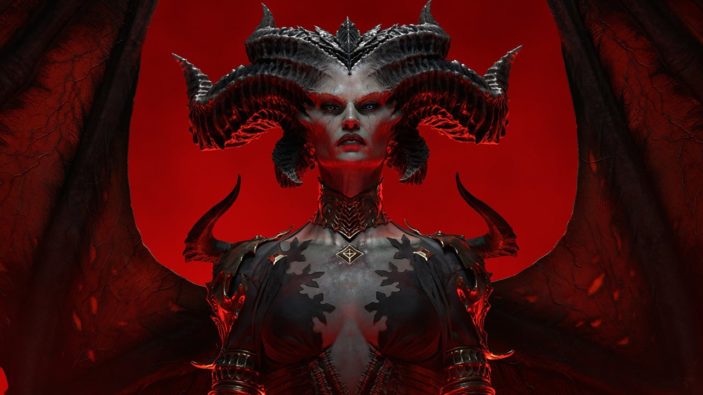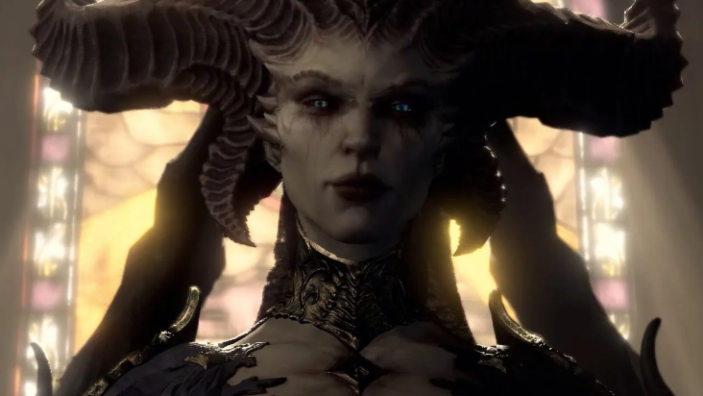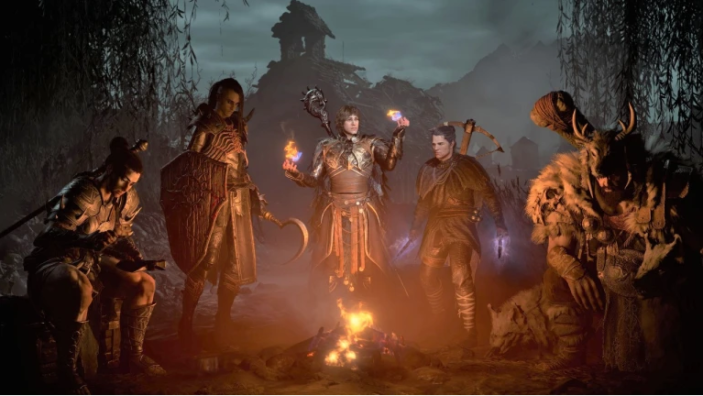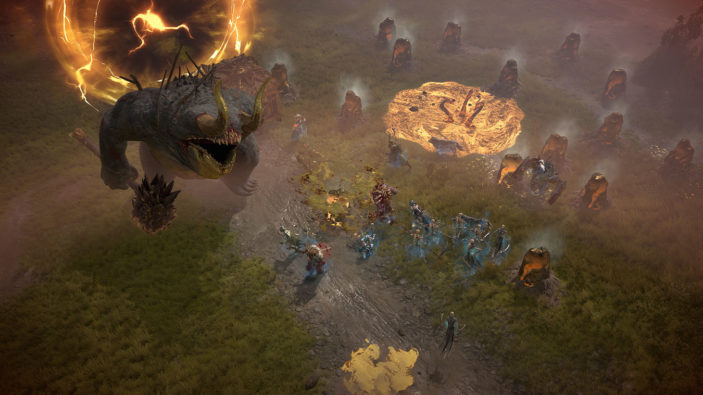
I had never really played much of the Diablo series. While I had played each of them in some way or at some point in my life, they’ve never really stuck with me. Be it the ageing mechanics and visuals of Diablo and Diablo II on the PC, to the early days of Diablo III, I’ve been meaning to get back into something that’s going to keep me around for the long run.
With that, I’m happy to say that Diablo 4 is undoubtedly one of the best action RPGs in the business and possibly the best game in the series. Its combat is fast and fluid, the environments vast, detailed and expansive, and the endgame is something to be admired, as it’s arguably the more important and lasting aspect of the entire experience. While the narrative can take a back seat at times, it does provide a few interesting boss encounters and a menacing villain in Lilith.
Hell on Earth
After a brief introductory cutscene, we see the return of Lilith, daughter of Mephisto, as she seeks to possess and slaughter the inhabitants of the world of Sanctuary. When it comes to narrative depth and emotional resonance, there’s not much to write home about. While that’s admittedly never been the focus, Diablo 4 does indeed throw out a few creepy cutscenes, usually dedicated to the rise of Lilith.
There are certain conversations had with Lilith throughout the narrative, via events I would rather not spoil, which do dive into some interesting aspects, questioning your role and intentions within the narrative. But for the most part, the narrative takes a back seat until it’s ready to throw a boss or two at you, during its more important moments.

Thankfully, it does a great job at taking you across the expansive open world of Sanctuary, from snowy mountains to town villages and hellish dungeons. There’s certainly a lot to explore, so I’d recommend progressing towards getting a mount to ride around and utilising fast travel back to town squares where possible.
Given Diablo 4’s endgame is crucial to the longevity and enjoyment beyond the story, things are left on a relatively flat note, even if it promises a certain continuation for the franchise beyond this point.
It’s also worth noting here that Diablo 4 also looks fantastic, and runs just as well. Environments look polished and detailed, while next-gen consoles carry a solid 4K/60FPS with rarely any drops in frame rate. Occasional bugs and glitches do pop up from time to time, but I found it more annoying to push through occasional server issues which see things grind to a halt.
Putting Up a Fight
If you’ve played a Diablo game before, you’ll feel right at home with Diablo 4’s combat. It’s fast and fluid, with a tight gameplay loop that sees you taking on a number of enemies and bosses with each passing minute. With a number of weapons and abilities to utilise in combat, things rarely get repetitive, nor does combat wear thin after multiple hours.
It also works great on a controller, with most of your abilities confined to the four face buttons and four shoulder buttons for ease of use. It can get a little confusing when you’re mixing up abilities and reassigning them to new commands, but I feel as though that’s a testament to the game’s variety in allowing you to mix an impressive number of unique and upgradeable abilities in the first place.
Of course, each of the 5 customisable classes is equipped with its own unique traits and abilities, one of which will be confined to one of your face buttons, or triangle and Y on PlayStation and Xbox controllers respectively. Each of these classes is simply fantastic to use, focusing on unique opportunities and accommodating various playstyles. While I focused mainly on building my Necromancer, I did dive back in to try the Barbarian. While I appreciate the Necroamncer’s ability to resurrect minions from the dead to fight with you in battle, I also appreciated the Barbarian’s Whirlwind ability, which gave me the chance to smash multiple foes in one swoop.

But I would recommend picking a magic-based class like the Sorcerer, Rogue, Necromancer or Druid for their more exciting and rewarding combat, as melee encounters can feel a little floaty at times, lacking the intended punch and weight. That being said, I only felt this with the Barbarian class. Beyond that, the Sorcerer can utilise elemental magic to freeze and burn enemies, while the Druid can change into animal form, and finally, the Rogue can take advantage of combustible magic.
But the fact that Diablo 4 even offers up this many ways to play feels like the tip of the iceberg. Along the way, you’ll be able to discover new weapons and gear that level up your damage output and defensive capabilities. You can also equip gear like skulls and books, which can be carried around to provide extra buffs to things like critical hits and ability cooldown times and general effectiveness.
When it comes to those abilities, players can upgrade an extensive skill tree by selecting which abilities to unlock and equipping them on the fly. They can be upgraded, but you’ll usually find yourself progressing through most of the skill trees before finding your favourites. I ended up finishing the story at around level 40, and I felt like I still had much more to do. And that’s exactly what we’ll touch on below.
The Endgame
Throughout the narrative, you’ll be able to select from two world tiers, Adventurer and Veteran. Labelled as World Tier 1 and World Tier 2 respectively, they act as difficulty levels for enemies, with the higher world tier increasing the game’s difficulty, but providing better loot and higher chances of obtaining rare gear.
The only issue with each of these world tiers comes at around 10 hours in. When I found my groove, I felt like each of these two tiers was incredibly easy, as I had only died a couple of times throughout the story. It does give players the ability to experience a relatively smooth pace and it’s rarely frustrating, but I felt a little too overpowered at times.

Thankfully, the endgame unveils much of Diablo 4’s meatiest content. Whether you’re striving to level up your character to the current maximum level of 100, or fleshing out your skill tree and gear, you’ll most likely be grinding towards unlocking new world tiers. World Tier 3 and 4, labelled Nightmare and Torment respectively, are locked and reserved for the endgame. In order to unlock these, however, you must take part in the Cathedral of Light and Fallen Temple Capstone dungeons in order to access them. But keep in mind, each dungeon comes with its hefty recommended levels. While in World Tier 2, you won’t be taking on the first Cathedral of Light challenge until you’re between levels 50-70. It’s also where online cooperative play matters. While up to three players can join you, you will have to play on the same world tier.
As you would expect, that large level bracket provides most of the challenges. You’re certainly encouraged to level up as much as possible and in every way, be it your abilities or gear. But given you would have spent more than 25 hours with Diablo 4 up until this point, no defeat ever feels cheap. There’s a fantastic blend of skill and strategy involved, that it never feels like the game is cheating you out of a fight.
There’s certainly a grind to undertake, and there is a hefty amount of microtransactions on top of a dedicated Battle Pass system, which sees you unlocking exclusive content as you level up. While you can buy and sell weapons and gear out in the open world with in-game currency, Diablo 4 does pinch the wallet if you want to get a leg up fast. But even so, it never feels essential. It’s only a matter of time before the max players undoubtedly spend money to keep them invested, but the journey to max level is one that can be done on the cheap; should you have the time.
Final Thoughts
Diablo IV feels less like a revolution and more like a pristine evolution. It’s refined and downright addictive while staying true to its expansive roots and dedicated systems that have made the franchise so successful.
While I would recommend newer fans give this one a go, there’s no doubt that returning fans will love this for its fantastic gameplay, polished visuals, deep customisation and progression and ultimately rewarding endgame.
FIVE STARS (OUT OF FIVE)
Highlights: Addictive gameplay; Solid performance; Rewarding and expansive endgame content
Lowlights: Narrative portion lacks challenge; Server issues can halt gameplay
Developer: Blizzard Entertainment
Publisher: Blizzard Entertainment
Platforms: PlayStation 5, PlayStation 4, Xbox Series X/S, Xbox One, Windows PC
Available: Now
Review conducted on PlayStation 5 with a pre-release code provided by the publisher.
